RBA head of financial stability, Luci Ellis, delivered few days ago a speech at Financial Markets Conference in Atlanta. Ms Ellis “explained” why the US housing market bubbled and then busted, and why the Australian housing market will not burst. She made several arguments why we are different. All of them wrong. I will concentrate here on two points:
The first is that housing supply is quite elastic here, at least in enough parts of the country to matter. The housing boom was a construction boom as well as a price boom. As a result, by 2006 there was already a substantial overhang of excess supply (Graph 1). The inherent stock-flow interaction in the housing market means that construction booms sow the seeds of their own destruction. Prices can undershoot formerly sustainable levels.US construction in 2000s was (in nominal terms) lower than in 1970s and 1980s. In relative terms (relative to population or total existing housing stock) construction rate at the peak in mid 2000s was by far lower than in all previous decades.

This is what she calls US “construction boom”. During the same period we were building at the rate of almost 2%.
More interestingly, in states where developments were restricted construction “boom” was lower while bubble was bigger. Supply side restrictions just amplify house price growth but don’t stop prices from falling. Places with the most supply restrictions (Las Vegas, California …) recorded largest house price drops although none of supply restrictions was lifted in meanwhile. Places with no restrictions like Texas or Georgia recorded no price growth.
This links to the third factor, which is that a range of tax and legal differences, as well as industry convention, created a system that discouraged amortisation. Interest-only loans, explicitly negative amortisation loans and cash-out refinancing, all meant that loan-to-valuation ratios that were high at origination, stayed high well into the life of the loan. American households are less likely to pay their mortgages down ahead of schedule than Australians (Graph 2). Trade-up buyers seem to have high loan-to-valuation ratios in the United States; that doesn't appear to be true in Australia. The result of all this is that the US housing stock is far more leveraged than that in Australia, even during the boom period (Graph 3).
While it's true that Australia does not provide tax benefits for PPOR mortgages it provides significant benefits for property investments. Americans have interest in not paying mortgages ahead of schedule, while Australians don’t. Even with this “advantage” Australians managed to increase LVR during housing boom while Americans decreased it. Australians were adding more debt and much faster (relative to home prices) than they are able to repay ahead of schedule. So, we are paying mortgage faster but or those mortgages grew so quickly that debt is skyrocketing.

Australia has higher percentage of interest only loans which shows that less people in Australia are interested in owning house – these people only think about price speculation. Since boom started we increased out leverage by almost 50% while Americans decreased their leverage during boom years (by almost 10%). After house price fell US leverage jumped up to level almost 50% higher than pre-boom levels. When our bubble bursts leverage will jump to levels at least 150% higher than pre-boom period (probably 200% or even more). It’s already 50% up.
RBA is already left with very little credibility and this is just one more step toward losing all of it.
No comments:
Post a Comment